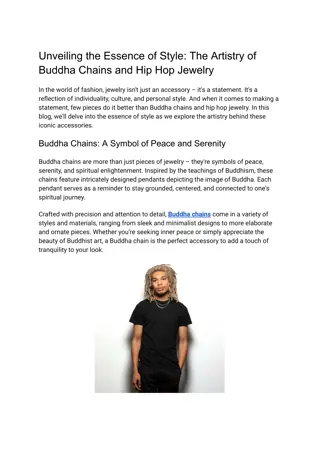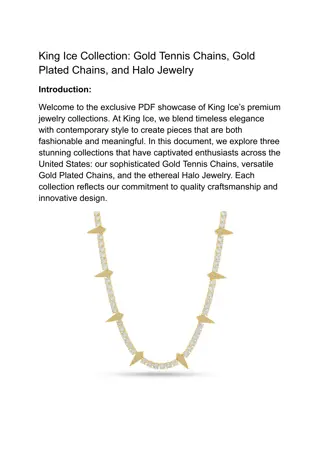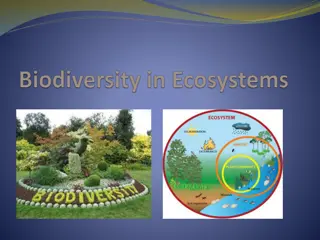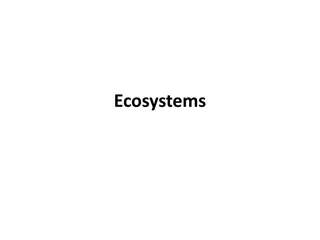Understanding the Intricacies of Food Chains in Ecosystems
Food chains play a crucial role in the transfer of energy within ecosystems. They consist of various trophic levels where organisms either consume or are consumed by others. Different types of food chains like grazing, detritus, predator, and parasitic chains interact to maintain the balance of energy flow. Understanding these dynamics is essential to comprehend the functioning of ecosystems.
Download Presentation

Please find below an Image/Link to download the presentation.
The content on the website is provided AS IS for your information and personal use only. It may not be sold, licensed, or shared on other websites without obtaining consent from the author. Download presentation by click this link. If you encounter any issues during the download, it is possible that the publisher has removed the file from their server.
E N D
Presentation Transcript
Food chain is the sequence of the eaters being eaten is called food chain The various steps in the food chain is called Trophic level Owing to repeated eating being eaten, the energy is transferred from one trophic level to another trophic level The transfer of energy from one trophic level to another is called energy flow There are three trophic levels of food chain in upwelling areas and five in marine environments Normally four trophic levels of food chain in a pond ecosystem. Shorter the food chain greater the energy tranfer. Energy flows in an ecosystem through the food chain in a unidirectional and at steady state.
TYPES OF FOOD CHAIN There are two basic types of food-chains in aquatic ecosystems Grazing food chain Detritus food chain Grazing food chain Starts with green plants and ends with carnivores via herbivores Producers - own food in the presence of sunlight The herbivorous eat the producers and the carnivores are eaten by the top carnivores
Predator food chain Predator food chain one animal captures and devours another animal The animal which kills other animals for food is called a predator This act of hunting is called predation Animals that are caught and eaten by a predator are called prey Predators that only eat the meat of prey are carnivores
Parasitic food chain The plants and animals of the grazing food chain are affected by parasites Parasites derive their energy from their hosts The parasitic chain is formed with in the grazing food chain
Detritus food chain Detritus food chain starts from the dead organic matter and ends with inorganic matter This consists of decomposers such as bacteria and fungi Decompose the organic matter and convert to inorganic matter Helpful for plants to prepare their food
Groups of organisms feed excessively on dead bodies of animals and plants are called as detrivores (consists of algae, bacteria, fungi) The Crustaceans Crab, Shrimps, Amphipods; Molluscans Clams; Nematode worms etc. groups of detrivores includes Protozoans; Insects; Polychaete worms;
FOOD WEB Path way that transfer energy form a given plant or plants through a given series of consumer is called food chain Food webs - important in maintaining the stability of an ecosystem The interlocking of many food chains is called food web Food web - non linear flow of energy Food web - a set of interconnected food chains by which energy and materials circulate within an ecosystem
The food web is divided into two broad categories The grazing web - begins with green plants, algae, or photosynthesizing plankton and Detritus web - begins with organic debris In a grazing web, materials typically pass from plants to plant eaters (herbivores) to flesh eaters (carnivores) In a detritus web, materials pass from plant and animal matter to bacteria and fungi (decomposers), then to detritus feeders (deprivers) and then to their predators (carnivores).
ECOLOGICAL PYRAMIDS Ecological pyramid (trophic pyramid) - the graphical representation of the trophic structure such as number, biomass and energy of an ecosystem First proposed by Charles Sutherland Elton (1927) and hence these ecological pyramids are called Eltonian pyramid Begins with producers on the bottom and proceed through the various trophic levels, the highest of which is on top There are three types of ecological pyramids viz. pyramid of numbers, pyramid of biomass and pyramid of energy.
TYPES OF ECOLOGICAL PYRAMIDS Pyramid of Biomass (g /m2/ day) Pyramid of Energy (calories) Pyramid of Number (No /m2/day)
Pyramid of number Shows the number of organisms at each trophic (relating to nutrition) level Here the number of individuals at the trophic level decreases from the producer level to the consumer level In an ecosystem, the number of producers is far high and the number of consumers in the subsequent trophic levels are lesser than that of the producers Example: In a pond ecosystem, the number decreases in the following order Phytoplankton Zooplankton Small fishes Large predatory fishes
Pyramid of biomass Biomass refers to the total weight of living organisms in a unit area Ecological pyramid of trophic level by quantifying the amount of biomass present at each trophic level biomass shows the relationship between biomass and The pyramid of biomass is an upright one (the apex is pointed upwards) in all terrestrial ecosystems In certain ecosystems like pond ecosystem, the pyramid of biomass is an inverted type of pyramid (apex is pointed downwards) - contain less amount of biomass of producers and more amount of biomass of consumers (fishes)
Pyramid of energy In the food chain, energy that was originally stored by the autotrophic plants is dissipated along the food chain More trophic links or levels in the food chain - dissipated or unusable energy loss will also be more There is generally a 90 percent loss at each level of the food chain, creating a pyramid-shaped diagram that is wider at the bottom and narrow at the top Example: In a pond, maximum energy is stored by the phytoplankton. Then, the energy decreases when it is transferred to the subsequent consumer levels.























